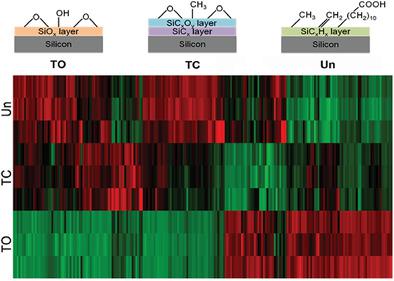Our official English website, www.x-mol.net, welcomes your
feedback! (Note: you will need to create a separate account there.)
Tandem-Mass-Tag Based Proteomic Analysis Facilitates Analyzing Critical Factors of Porous Silicon Nanoparticles in Determining Their Biological Responses under Diseased Condition.
Advanced Science ( IF 14.3 ) Pub Date : 2020-06-23 , DOI: 10.1002/advs.202001129 Yunzhan Li 1, 2 , Zehua Liu 3 , Li Li 1, 2 , Wenhua Lian 1, 2 , Yaohui He 4 , Elbadry Khalil 3 , Ermei Mäkilä 5 , Wenzhong Zhang 6 , Giulia Torrieri 3 , Xueyan Liu 1, 2 , Jingyi Su 1, 2 , Yuanming Xiu 1, 2 , Flavia Fontana 3 , Jarno Salonen 5 , Jouni Hirvonen 3 , Wen Liu 4 , Hongbo Zhang 7 , Hélder A Santos 3, 8 , Xianming Deng 1, 2
Advanced Science ( IF 14.3 ) Pub Date : 2020-06-23 , DOI: 10.1002/advs.202001129 Yunzhan Li 1, 2 , Zehua Liu 3 , Li Li 1, 2 , Wenhua Lian 1, 2 , Yaohui He 4 , Elbadry Khalil 3 , Ermei Mäkilä 5 , Wenzhong Zhang 6 , Giulia Torrieri 3 , Xueyan Liu 1, 2 , Jingyi Su 1, 2 , Yuanming Xiu 1, 2 , Flavia Fontana 3 , Jarno Salonen 5 , Jouni Hirvonen 3 , Wen Liu 4 , Hongbo Zhang 7 , Hélder A Santos 3, 8 , Xianming Deng 1, 2
Affiliation

|
The analysis of nanoparticles’ biocompatibility and immunogenicity is mostly performed under a healthy condition. However, more clinically relevant evaluation conducted under pathological condition is less known. Here, the immunogenicity and bio–nano interactions of porous silicon nanoparticles (PSi NPs) are evaluated in an acute liver inflammation mice model. Interestingly, a new mechanism in which PSi NPs can remit the hepatocellular damage and inflammation activation in a surface dependent manner through protein corona formation, which perturbs the inflammation by capturing the pro‐inflammatory signaling proteins that are inordinately excreted or exposed under pathological condition, is found. This signal sequestration further attenuates the nuclear factor κ B pathway activation and cytokines production from macrophages. Hence, the study proposes a potential mechanism for elucidating the altered immunogenicity of nanomaterials under pathological conditions, which might further offer insights to establish harmonized standards for assessing the biosafety of biomaterials in a disease‐specific or personalized manner.
中文翻译:

基于串联质量标签的蛋白质组学分析有助于分析多孔硅纳米粒子的关键因素,以确定其在患病条件下的生物反应。
纳米颗粒生物相容性和免疫原性的分析大多在健康条件下进行。然而,在病理条件下进行的更具临床相关性的评估却鲜为人知。在这里,在急性肝脏炎症小鼠模型中评估了多孔硅纳米颗粒(PSi NP)的免疫原性和生物纳米相互作用。有趣的是,PSi NPs可以通过蛋白冠形成以表面依赖性方式缓解肝细胞损伤和炎症激活,通过捕获在病理条件下过度分泌或暴露的促炎信号蛋白来扰乱炎症。成立。这种信号隔离进一步减弱了核因子κ B 通路的激活和巨噬细胞产生的细胞因子。因此,该研究提出了一种阐明病理条件下纳米材料免疫原性改变的潜在机制,这可能进一步为建立以疾病特异性或个性化方式评估生物材料的生物安全性的统一标准提供见解。
更新日期:2020-08-05
中文翻译:

基于串联质量标签的蛋白质组学分析有助于分析多孔硅纳米粒子的关键因素,以确定其在患病条件下的生物反应。
纳米颗粒生物相容性和免疫原性的分析大多在健康条件下进行。然而,在病理条件下进行的更具临床相关性的评估却鲜为人知。在这里,在急性肝脏炎症小鼠模型中评估了多孔硅纳米颗粒(PSi NP)的免疫原性和生物纳米相互作用。有趣的是,PSi NPs可以通过蛋白冠形成以表面依赖性方式缓解肝细胞损伤和炎症激活,通过捕获在病理条件下过度分泌或暴露的促炎信号蛋白来扰乱炎症。成立。这种信号隔离进一步减弱了核因子κ B 通路的激活和巨噬细胞产生的细胞因子。因此,该研究提出了一种阐明病理条件下纳米材料免疫原性改变的潜在机制,这可能进一步为建立以疾病特异性或个性化方式评估生物材料的生物安全性的统一标准提供见解。











































 京公网安备 11010802027423号
京公网安备 11010802027423号